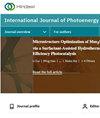Energy Efficiency and Feasibility Analysis of Solar Power Generation Using Hybrid System of an Educational Institution in Malaysia
IF 2.1
4区 工程技术
Q3 CHEMISTRY, PHYSICAL
引用次数: 0
Abstract
Energy is one of the basic inputs and driving forces for economic and social development modernization. Sustainable energy supply is one of the major challenges in the modern world. Sustainable energy supply can be obtained through alternative energy sources, and efficient energy use is a high priority to optimize the environmental impact. This paper investigates the potential for energy savings involving five end-load equipment in academic institutions. The saving potential is obtained through energy efficiency analysis and feasibility analysis of the solar power generation systems. An energy audit is conducted on end-use consuming equipment (i.e., fans, lights, air conditioning, ICT equipment, etc.) in these five end-load sectors to find out the major energy-consuming equipment, energy consumption, and potential energy savings. The analysis of energy consumption per equipment helps determine the appropriate type of equipment to be upgraded and replaced for energy saving. The feasibility of rooftop solar power generation has been also analysed to integrate into the energy end load. The research findings confirm that laboratory equipment, lighting, and air conditioning are vital to energy consumption in academic buildings. The energy savings, bill savings, and carbon emissions reductions have been estimated based on integrating rooftop solar power generation. The feasibility analysis of onsite energy generation using a hybrid solar system found that the total energy-saving potential and bill savings within five years are 311,131 kWh and RM 113,563, respectively. This value refers to comprehensive energy-saving and bill for all academic buildings involved in this research.马来西亚某教育机构混合系统太阳能发电的能效及可行性分析
能源是经济社会发展现代化的基本投入品和动力之一。可持续能源供应是当今世界面临的主要挑战之一。可持续的能源供应可以通过替代能源获得,高效的能源利用是优化环境影响的重中之重。本文研究了学术机构中五种终端负荷设备的节能潜力。通过对太阳能发电系统的能效分析和可行性分析,得出了节能潜力。本署对这五个终端负荷组别的最终用途消耗设备(即风扇、电灯、空调、资讯及通讯科技设备等)进行能源审计,以找出主要的能源消耗设备、能源消耗和可能节省的能源。通过对每台设备能耗的分析,可以确定需要升级和更换的设备类型,从而达到节能的目的。分析了屋顶太阳能发电纳入能源末端负荷的可行性。研究结果证实,实验室设备、照明和空调对学术建筑的能源消耗至关重要。以整合屋顶太阳能发电为基础,估算出了节约能源、节省电费、减少碳排放的效果。利用混合太阳能系统现场发电的可行性分析发现,五年内的总节能潜力和电费节省分别为311,131千瓦时和113,563令吉。该值是指本研究涉及的所有学术建筑的综合节能和账单。
本文章由计算机程序翻译,如有差异,请以英文原文为准。
求助全文
约1分钟内获得全文
求助全文
来源期刊
CiteScore
6.00
自引率
3.10%
发文量
128
审稿时长
3.6 months
期刊介绍:
International Journal of Photoenergy is a peer-reviewed, open access journal that publishes original research articles as well as review articles in all areas of photoenergy. The journal consolidates research activities in photochemistry and solar energy utilization into a single and unique forum for discussing and sharing knowledge.
The journal covers the following topics and applications:
- Photocatalysis
- Photostability and Toxicity of Drugs and UV-Photoprotection
- Solar Energy
- Artificial Light Harvesting Systems
- Photomedicine
- Photo Nanosystems
- Nano Tools for Solar Energy and Photochemistry
- Solar Chemistry
- Photochromism
- Organic Light-Emitting Diodes
- PV Systems
- Nano Structured Solar Cells

 求助内容:
求助内容: 应助结果提醒方式:
应助结果提醒方式:


